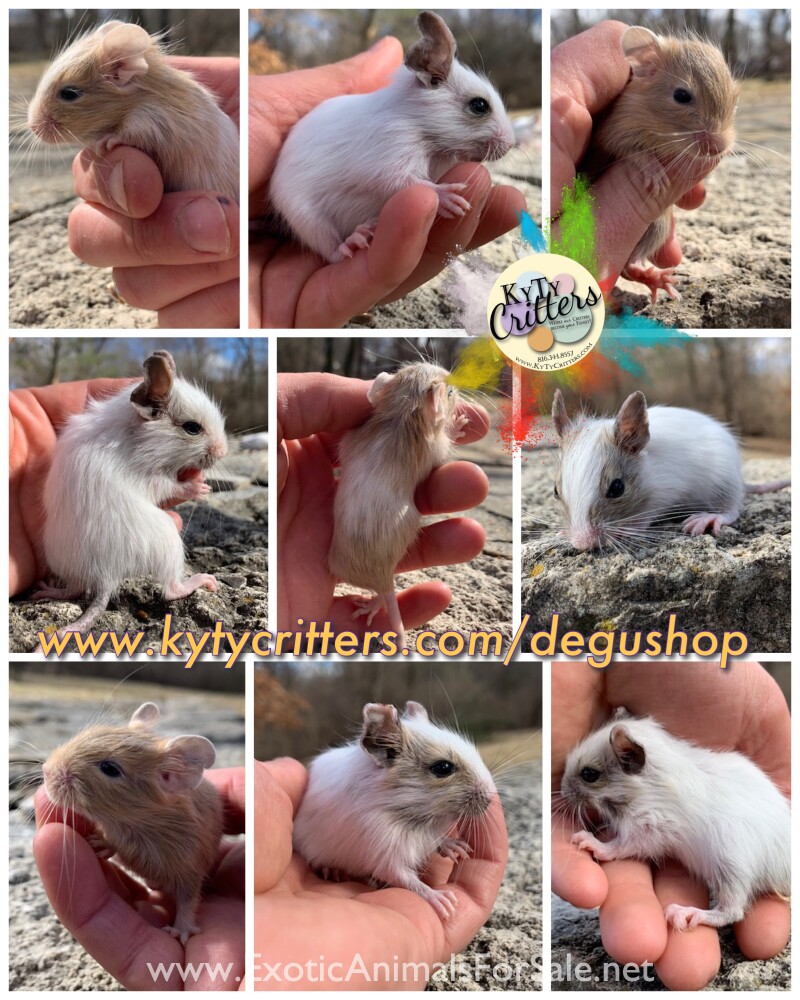Degu For Sale
Found in central Chile, the degu is a rodent that is akin to a chinchilla or guinea pig. Degus reach a maximum size of about nine and a half inches to twelve inches in length and a weight of six to twelve ounces. It has a long, thin tail that ends in a tuft of black fur. It is covered with brown fur with lighter colored fur around its eyes and neck. The animal’s cheek teeth are formed is a figure-eight shape, which is why the degu’s genus name is “octodon”.

Degu Babies- Buy one get one free!
- Name: KyTy Critters
- Posted: 01/07/2026
- Phone: 816-344-8557
- Email: Email Seller
- Location: Missouri
- Website: http://www.kytycritters.com
We offer lifetime support for any questions or concerns you have!!!! For more information (including SHIPPING, AVAILABILITY, PHOTOS, PRICES & MORE) please visit our website: www.kytycritters.com Feel free to text us with any questions not answered by...

Degu Babies
- Name: KyTy Critters
- Posted: 11/18/2025
- Phone: 816-344-8557
- Email: Email Seller
- Location: Missouri
- Website: http://www.kytycritters.com
We offer lifetime support for any questions or concerns you have!!!! For more information (including SHIPPING, AVAILABILITY, PHOTOS, PRICES & MORE) please visit our website: www.kytycritters.com Feel free to text us with any questions not answered by...

Degu
- Price: 50-100
- Name: Chancy Eckert
- Posted: 07/14/2025
- Phone: 7576391134
- Email: Email Seller
- Location: North Carolina
- Website: https://www.carolinaquillery.com/degu
Blue and pied baby degus ready. $50 each. must purchase in pairs or trios. Shipping available at additional cost
Degu
A large, multilevel cage like the ones made for chinchillas or ferrets would be ideal for a degu. The minimum size should be 24-inches by 18-inches by 24-inches. Degus are voracious chewers so the cage should be made of wire, not wood. Degus are prone to foot problems, too, so they need cages with solid flooring rather than wire. Cedar or pine bedding should be avoided. Paper-based bedding is much safer. The cage should have a nesting box so that the animal has a place to go where it feels secure.
What do Degu Eat in Captivity?
In the wild, degus eat a diet that is high in roughage and low in carbohydrates. In captivity, these animals should be fed a combination of guinea pig or chinchilla pellets along with timothy hay and a variety of fresh vegetables. They can be given uncooked carrots, sweet potatoes, green beans, and broccoli. They also like leafy greens such as spinach or kale, and can eat dandelion leaves as a special treat. They should avoid eating fruits due to the high sugar content.
Degu Enrichment
Degus need lots of exercise so a running wheel, preferably one that is at least 11 inches in diameter, will give the animal ample opportunity to run. Thick branches placed in the cage will give the degu spots to climb and to chew. In fact, they should be given plenty of chew toys, wood blocks, and willow balls. The degu will climb on cotton ropes and enjoys sitting on loft perches. Toys designed for parrots can also be used to entertain the animal.
Breeding Degu in Captivity
Breeding time for the degus in the wild usually starts when the area begins receiving twelve hours of sunlight per day, but they are breed year round in captivity. The gestational period is about three months, after which the female gives birth to, on average, about six pups. The babies should be held only minimally during the first three weeks so that they are not stressed out. They will be weaned at about six weeks of age.







Comments